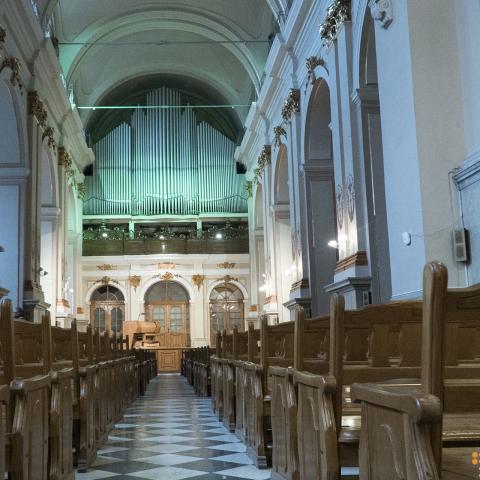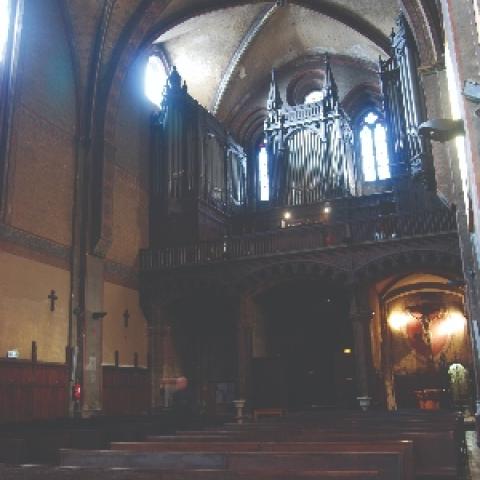Dr. Girenas Povilionis (born 1976), PhD in humanities/art criticism (2006), is associate professor at the Lithuanian Academy of Music and Theater. He is a senior specialist at the Center for Culture Heritage, an organ historian, researcher and restorer, and gives lectures at the Lithuanian Academy of Music and Theater and Grigalius Center for Church Music Studies. Since 2021 he has been a member of the Commission for the Certification of Movable Cultural Property Restorers; in 2009–2018 he was a member of the Restoration Council of the Ministry of Culture of the Republic of Lithuania.
Between 2009 and 2011 he was a postdoctoral fellow funded by the European Union Structural Funds project “Postdoctoral Fellowship Implementation in Lithuania” at the Lithuanian Culture Research Institute. In 2000, he completed his studies for a Master of Arts degree in organ at the Lithuanian Academy of Music and Theater. He advanced his skills in organ building and restoration in France in 1999 and 2000, supervised by Michel Chapuis and Dominique Lalmand, at Gotland University in Sweden in 2001 and 2006, and at the Center for Organ Art (GoArt) at Gothenburg University in 2001 and 2002.
In 2007, Povilionis established the Center for Organ Heritage in Lithuania. Currently he implements the restoration of large historical pipe organs in the main churches in Lithuania, e.g., Adam
Gottlob Casparini’s 1775–1776 grand organ in the Dominican Church of the Holy Spirit in Vilnius (organ replica built for Christ Church, Rochester, New York); an organ in the chapel of The Gates of Dawn (Aušros Vartai), Vilnius; a 25-stop Romantic organ by Juozapas Radavicius at the church in Žemaic€ių Kalvarija; a Baroque organ with a Romantic-era addition by Wacław Biernacki in Pivašiunai, an important sanctuary in Lithuania. Among his recently restored projects are a 1938 instrument by Otto Kratokvil with a Baroque façade in Telšiai Cathedral and the late-Baroque two-manual organ in the Žemale church, as well as other organs in Lithuania.
Povilionis’s scientific activities encompass research into historic organs and the issues of the preservation and restoration of this heritage. He has presented his research at international conferences and congresses in Lithuania, Latvia, Estonia, France, Sweden, the United Kingdom, the United States, Denmark, Poland, and Portugal; delivered workshops in various towns in Lithuania and given lectures at the Latvian J. Vitols Academy of Music. He has published over forty scientific articles and two monographs (The Late Baroque Organ Building Art in the Grand Duchy of Lithuania, 2013; and The Lithuanian Organ Art: from Baroque to Classicism. Organ Catalogue. 17th c.–1st half of the 19th c., 2009), and is currently writing his third monograph on peculiarities for Vox humana pipe ranks that have survived in authentic Lithuanian Baroque organs, funded by the Research Council of Lithuania. He has managed the three-CD project Lithuanian Historical Organs and the 2008 Days of Cultural Heritage in Lithuania. For more information: www.vargonai.com.

Editor’s note: the first part of this series appeared in the September 2021 issue of The Diapason, pages 14–21.
RELATED: Part 1
This article illuminates a unique collection of drawings depicting ten organ façade designs dating from the latter part of the eighteenth century. The collection titled Ruzne rysunki is stored in the Old and Rare Books Department at the Library of Vilnius Academy of Arts, Lithuania. The drawings are of inestimable value to the history of Lithuanian pipe organs; as well, this manuscript is also significant to the European history of pipe organs at large.
The first part of this series presented the historical background of the leather-bound album of drawings and analyzed eight drawings (numbers 7, 11, 13, 16, 18, 21, 23, and 25) out of 10, commenting on the old inscriptions and identifying the possible locations of projected Baroque organs as well as raising the hypothesis of authorship. The attribution of old drawings to the area of the so-called Vilnius organ building school is based on the comparison to the extant examples of Baroque pipe organs in Lithuanian territories. Some of the drawings represent the two-tower Baroque and Rococo façade compositions (consisting of two tall towers at the sides of the façade, a lower triangular tower in the center, and two intermediate flats, curving upwards, as in drawing numbers 16, 18, 21, and 25), which is particularly common among works by Vilnius organ builders.
This second part of the series continues the analysis of the drawing numbers 9 and 6, the first showing the typical two-tower architecture with Rococo ornamentation and resembling that discussed last month, and the second in a Doric style and appearing as a precise copy of the organ façade designs from a 1780 French textbook.
Drawing number 9
The façade in drawing number 9 is marked by a unique structure with two lateral towers (Figure 11), which suggests that the organ design might have been made for a church with a window in the rear wall, since the entire structure is arranged around the central axis to enclose the window. The façade design in this drawing has structural similarities to those in drawing numbers 18 and 21; its centerpiece resembles that of the façade in drawing number 7 (Figure 5). Nevertheless, drawing number 9 is analyzed individually because with regard to style, it dates from a later period and displays a different drawing manner.
Rococo ornamentation in this drawing is manifest in the plasticity of the wings and the lattice grille in front of the pipes and keydesk, all decorated with rocaille and plant-inspired ornaments; the towers are crowned with statues of angels. It is not known whether the design was implemented, yet its centerpiece bears some similarity to that of the organ built at the beginning of the nineteenth century in Paluše Church (Figure 5c).
Drawing number 6
The façade structure in drawing number 6 (Figure 12) dates from the latest period, possibly from the beginning of the nineteenth century. It is a Classical type characterized by the architectural composition found in buildings and interior structures. Presumably the compiler of the album, Jonas Danauskas, named the façade as Doric (a Polish inscription says Dorycki).
It might be assumed that the façade of the 1819 organ of Raseiniai Dominican Church,14 which has not survived, and the old façade of the Vilnius Cathedral organ, which in the 1833 record was described to be of “Doric style,” resembled the design featured in drawing number 6. It was initially believed that the drawing had been used to build the organ in Anciškis Church at the beginning of the nineteenth century (Figure 12a). However, after examining the organ in 2012, it was discovered that upon transferring the instrument to this location,15 the upper part of the façade, the second storey, was simply cut off.
It is interesting to note that the Classical organ façade in drawing number 6 seems to be a precise copy of some drawings in the organ façades catalogue found in a 1780 French textbook of architecture by Jean-François de Neufforge, Recueil elementaire d’architecture (Paris, 1780) (French examples of Classical organ façade presented in Figure 13a, b, c, and c).16 This book on architecture includes some authentic drawings in classical style—we may see a close resemblance between the discussed Lithuanian drawing number 6 and French drawing on page CCXII (Figure 13c).
§
The ten authentic organ façade drawings presented here reflect in general the features typical for the period of organ building that flourished into the Vilnius school of the late Baroque. Dating from approximately 1740 through 1850, Vilnius organ building played a significant role in the panorama of European organ building tradition, representing a unique and independent style of organs in Lithuania and neighboring territories (Belarus, Latvia, and Poland) that were formerly attributed to the Grand Duchy of Lithuania (GDL).
Notes
14. Raseiniai Dominican Church Inspection Act of 1820 (LVIA, f. 669, ap. 2, b. 224, l. 13v).
15. The church from which the organ was transferred to Anciškis has not been identified.
16. In his study (Nowozytny prospekt organowy i jego twórcy. Warszawa: instytut sztuki Pan, 2012, pp. 216, 335) Polish researcher Marcin Zglin´ski provides some examples with authentic sketches from the mentioned French catalogue, referring to the original source: Jean-François de Neufforge, Recueil elementaire d’architecture, Paris, 1780, vols. 5–6, p. 211. In fact, the organ façades were printed not in vols. 5–6, but as a supplement to the whole study, Supplément au Recueil élémentaire d’architecture contenant plusieurs études des ordres d’architecture d’après l’opinion des Anciens et le sentiment des Modernes, divers entrecolonnements propres à l’ordonnance des façades, divers exemples de décorations extérieures et intérieures, etc., à l’usage des monuments sacrés, publics et particuliers, composé par le sieur Neufforge, architecte, Volume 2, 1775–1780. The digitized collection may be accessed via Gallica database (gallica.bnf.fr), at https://bibliotheque-numerique.inha.fr/collection/item/15732-redirection [last accessed April 12, 2021].
Archival Sources
Butkiške Church Inspection Act of 1806. LVIA , f. 669, ap. 2, b. 221, l. 308v.
Butkiške Church Inspection Act of 1896. LVIA , f. 669, ap. 3, b. 2573, l. 53.
Joniškelis Church Inspection Act of 1804. LVIA , f. 1671, ap. 4, b. 3, l. 6.
Joniškelis Church Inspection Act of 1806. LVIA , f. 669, ap. 2, b. 221, l. 480.
Joniškelis Church Inspection Act of 1819. LVIA , f. 1671, ap. 4, b. 3, l. 1.
Joniškelis Church Inspection Act of 1845. LVIA , f. 669, ap. 2, b. 267, l. 144.
Kedainiai St. Joseph (Carmelite) Church Inspection Act of 1806. LVIA , f. 669, ap. 2, b. 221, l. 596.
Kedainiai St. Joseph (Carmelite) Church Inspection Act of 1820. LVIA , f. 669, ap. 2, b. 224, l. 147.
Krincinas Church Inspection Act of 1820. LVIA , f. 669, ap. 2, b. 222, l. 16.
Notenai Church Inspection Act of 1873. LVIA, f. 1671, ap. 4, b. 4, l. 708.
Raseiniai Dominican Church Inspection Act of 1820. LVIA, f. 669, ap. 2, b. 224, l. 13v.
Semeliškes Church Inspection Act of 1782. LVIA , f. 694, ap. 1, b. 3941.
Skaruliai Church Inspection Act of 1901. LVIA , f. 669, ap. 3, b. 2762, l. 122.
Suvainiškis Church Inspection Act of 1820. LVIA , f. 696, ap. 2, b. 29, l. 308.
Bibliography
[Lietuvos sąvadas] Lietuvos TSR istorijos ir kulturos paminklų sąvadas [Collection of History and Cultural Monuments in Lithuanian Soviet Republic]. Part 1, Vilnius, 1988.
Paknys, Mindaugas. “Vargonų meistrai Lietuvos Didžiojoje Kunigaikštysteъje” [Organ Builders in Lithuanian Grand Duchy]. Menotyra, No. 2 (23), Vilnius, 2001, pp. 52–61.
Povilionis, Girenas. Velyvojo baroko vargondirbystes menas Lietuvos Didžiojoje Kunigaikštysteje [The Late Baroque Organ Building Art in the Grand Duchy of Lithuania]. Vilnius: Vargonų paveldo centras, 2013.
Povilionis, Girenas. Vargondirbystes menas Lietuvoje: nuo baroko iki klasicizmo. Vargonų katalogas. xvii a.–xix a. pirmoji puse [The Lithuanian Organ Art: from Baroque to Classicism. Organ catalogue. 17th c.–1st half of the 19th c.]. Vilnius: Savastis, 2009.
Šv. Jokubo bažnycia [St Jacob Church in Vilnius]. Vilnius: LTSR Kulturos Ministerija, Paminklų restauravimo institutas, 1975.
Zglinski, Marcin. “Budownictwo organowe na terenie dawnego Wielkiego Księstwa litewskiego do około 1850 roku w s'wietle najnowszych badan´. Materiały.” Muzyka, Warszawa, 2003, No. 3, pp. 65–98.
Zglinski, Marcin. “Organmistrz, snycerz, stolarz, inwestor – z działalnosci osiemnastowiecznego wilenskiego warsztatu organmistrzowskiego. uwagi na bazie nowo odkrytych archiwaliów.” Przegląd Wschodni, Vol. 6, z. 2 (22), 1999, pp. 289–303.
Zglin´ski, Marcin. Nowozytny prospekt organowy i jego twórcy. Warszawa: instytut sztuki Pan, 2012.
This article is part of the project “Genesis and Comparative Study of Vilnius Baroque Organbuilding School Stops Vox Humana & Unda Maris: Adaptation of Caspari(ni) and Italian Traditions,” funded by the Research Council of Lithuania (LMTLT), agreement No. S-LIP-18-40.





